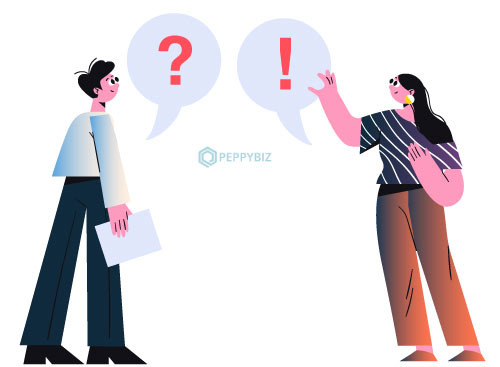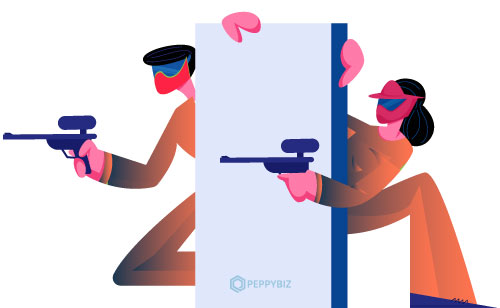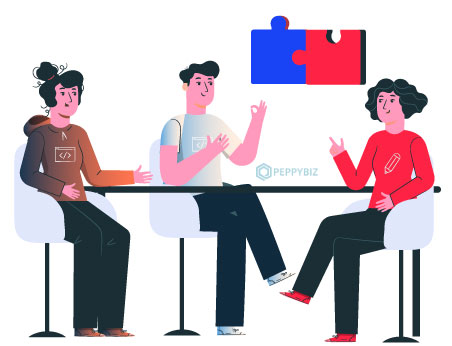20+ Effective Problem-Solving Activities For Your Team
Problems are an everyday part of our life that requires the right approach to handle them. Leaders see opportunity in every problem when others consider it as a roadblock. Problem-solving activities are a great way to build comradeship and decision-making ability in your team.
A research study conducted on college graduating students revealed a lack of problem-solving ability. As a result, most companies prefer to hire candidates who can take independent decisions in a crisis rather than having good grades. The problem-solving process requires detecting the problem, determining a correct course of action and execution.
Collective activities play an important role in team building. It focuses on collaboration, communication, adaptability, and decision-making.
Here are 20 effective problem-solving activities for your team.
1. Create Your Problem

In these problem-solving activities, team members need to brainstorm a problem and find a solution. First, small teams of 4-6 members are made. Next, a new problem is created, and teams are given one hour to discuss and come to a conclusion.
After one hour, as in a Hackathon presentation each team will present their solution verbally or with the help of a PowerPoint presentation. The team with the best solution is declared the winner. This activity helps in building team coordination, decision-making, and negotiation skills.
2. Shrinking Vessel
The activity starts by making a circle on the floor. All team members are required to stay within the circle. After every five minutes, the size of the circle is reduced.
The idea is to keep the team inside the shrinking space for a longer time. Then, as the circle reduces, you can find out how the team coordinates to keep themselves within the confined space. This problem-solving activity enhances cognitive diversity with adaptability.
3. Legoman

To begin, divide the team into small groups of 2 to 4 persons. Now select someone to make a Lego structure in 10 minutes. The competing team needs to replicate the structure by listening to the instructions. Only one team member can look at the original structure to give instructions.
The team needs to find means and ways to communicate the structure’s colour, shape, and size. In this problem-solving activity, communication ability is assessed.
4. Code Break

It is a virtual activity designed for remote teams. The teams compete via video conferencing. The problem-solving activity is effective with a small group of four people or thousands of members together.
The coordinator gives a clue, and each team is required to break the code. The activity enhances communication and problem-solving skills.
5. Letting Go
This problem-solving activity combines mind training and meditation. It trains team members to work in difficult situations and reduces work-related stress. The activity is guided by an expert who instructs the team with mind relaxation techniques.
6. Spaghetti Marshmallow Tower
For this activity, you need some marshmallows, strings, masking tape, and 20 uncooked spaghetti. The challenge is to build the tallest tower in the least possible time. This fun activity is beneficial for team building and coordination.
7. Go for Gold
This problem-solving activity is very similar to the spaghetti marshmallow tower. The only difference is that the tower is built using rubber tubing, pipes, and cardboard. A marble replaces the marshmallow on top. In addition, the structure is required to be taken from one point to another without dropping the marble.
8. Egg Drop
This problem-solving activity enhances decision-making. First, the team needs to transport eggs using raw materials such as straw, newspaper, rubber bands, and plastic wrap. Next, the team has to build an egg carrier, drop the egg in the carrier, and see which carrier doesn’t break the egg.
9. Scavenger Hunt
In this activity, each team is provided with a list of articles. The aim is to find these articles within a restricted premise and in a given time frame. The team which finds the maximum number of articles is the winner. This problem-solving activity is great for team coordination, time management, and decision-making.
10. Escape

This activity aims to decipher the clues and find a key. The team must find the key in a limited time to unlock the door. Usually, 45 minutes to an hour is given to solve the puzzle and find the key. The activity is designed to enhance team coordination, decision-making ability, and time management.
11. Frostbite
In this enacted problem-solving activity, teams are given a scenario of being trapped in the cold Siberian desert. One person from each team is nominated as the leader. The task is to build a snow shelter with provided materials.
The leader cannot help in the task, and he acts as having frostbite. Some members can lie down, enacting unconsciousness to make things more challenging, and some can be blindfolded as snow-blind. It is a great activity for evaluating leadership traits, team effort, and coordinated execution.
12. Human Chain

The problem-solving activity is designed to use the collective mental capacity to resolve a problem. First, the team stands in a circle making a chain by holding the person’s hand, not standing next to him. When a chain is formed, the challenge starts. Now the chain needs to be delinked without letting off the hands.
13. Dumbest Idea First

The name of the problem-solving activity will give you a clue. In this activity, a problem is suggested to the team. Then, each team has to come up with a dumb idea to solve the problem. The problem can be an imaginary or a real situation that the company is facing.
The ideas are evaluated once presented by teams on paper. Then, the probability of each solution is evaluated based on the chances of resolving the issue. Finally, the solution having zero probability is declared the winner. This exercise builds problem-solving ability with critical thinking. Similarly, when tackling a complex task like writing a dissertation, you might consider seeking help from experts and write your dissertation by PhDs to ensure quality and depth in your work.
14. Wool Web
Each team is given a yarn of wool, and they have to make a web out of it. All teams can start together, and 15 minutes are given for the task. Once completed, now rotate the teams to yarn web they have not created.
All teams will nominate a person to untangle the yarn web blindfolded. Team members can verbally guide the nominated person but cannot help physically. The team that untangles the web first wins.
15. Clue Me In
It is one of the most enjoyable problem-solving activities for teams. It helps in training the team for cognitive and logical thinking. To begin the task, select things related to your profession; now place all the things in a bag and let each team send a representative to pull out a clue. The team has to find the clue as quickly as possible to win.
16. Play FreeCell
Play out the popular card game as a team-based puzzle challenge. Although traditionally played solo, FreeCell can be a great collaborative activity where team members work together to plan moves, solve the layout, and talk through strategy. It encourages communication, logical thinking, and patience — all while keeping things light and fun. Also, multiplayer PC games can enhance employee engagement while boosting teamwork efficiency and collaboration.
17. Paintball

Paintball is another fun activity designed on the military pattern. There are two contesting teams in a predefined combat zone. The task is to fire paint pellets on the opposing team. The person who is hit is dead and out.
18. Problem Solving Box

It is an effective way to know your teams’ problems and help resolve them. A box is placed in the center called ‘The Problem-Solving Box.’ All members will write a problem on a piece of paper and put it inside the box. Now the paper is taken out, and the problem is read out loud. Finally, all members will give a workable solution for the problem. This problem-solving activity is a discrete way for management to understand the problems of its team.
19. Blind Drawing

The activity requires a pair of contestants sitting back-to-back. The first person describes an image without giving obvious clues, while the other draws the image as a guide. The team with the best communication technique and understanding wins.
20. Stranded
It is a great activity to enhance effective communication strategy. In this problem-solving activity, the team is locked in a room. The team has to consult each other and list ten items that they will need for survival. The items are listed in order of importance. The team that has the best thought of the list of the essential items is the winner.
21. Bonded Buddies

The activity groups teams into 5 to 6 people tied together, limiting their movement. In addition, each team has to cover a distance. The team that takes the least time is declared the winner.
It is a great activity for building team collaboration and collective problem-solving techniques. In addition, the group activity helps teams work together to resolve a problem.
Conclusion
One of the biggest challenges that organizations and companies face is people working in tight compartments. These 20 problem-solving activities are scientifically designed for team collaboration and decision-making ability. In addition, all these activities are easy and can be tried to improve your team’s capability.


